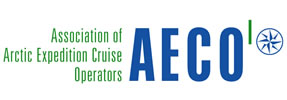Cruising in the Canadian Arctic ‘Problematic’
 |
| Hapag-Lloyd Bremen at Pond Inlet (University of Ottawa) |
The Canadian Arctic is one of the most ‘cumbersome, expensive and problematic regions in the world’ for expedition cruise operators, according to the Association of Arctic Expedition Cruise Operators (AECO).
More than 35 different Canadian authorities require over 50 applications and permits from cruise operators to visit the Arctic. This keeps visitors and economic activities away from Canada, AECO said in an open letter to stakeholders involved with permitting requirements or the political framework behind the requirements.
Numbers for the Canadian Arctic are very low. According to figures provided by AECO, 1,650 passengers visited in 2013, up from 1,200 in 2012 and the highest number recorded in nine years. In 2005, there were 550 passengers.
In contrast, last year approximately 45,000 passengers cruised to Svalbard and 20,000 to Greenland.
AECO said Canada has a great deal to offer tourists from all over the world and expedition cruise operators would like to continue to bring visitors and economic activity, but more cooperation from Canadian authorities is needed.
 |
| One Ocean’s Akademik Sergei Vavilov is a regular visitor to the Canadian Arctic (R Eime) |
The association complained that the list of permitting requirements ‘seems to be ever-increasing.’
It listed 52 permitting, licensing, clearance, inspection, review, certification, impact, registration and reporting requirements that may be applicable when operating in the Canadian Arctic.
Jackie Dawson, Canada research chair in environment, society and policy and assistant professor at the University of Ottawa, is working on an article that argues this situation limits economic development and local entrepreneurship opportunities and essentially yet unintentionally undermines some of the work being conducted by the same institutions that are implementing the permits.
Lack of clarity puts operators at risk of non-compliance, AECO added.
According to Hans Lagerweij, president and ceo of Toronto-based Quark Expeditions, ‘No Canadian body has been able to provide a complete list of requirements and/or a list of permitting authorities, so operators could easily oversee one or more requirements, which could result in a company unintentionally being non-compliant.
‘This complete lack of clarity is a serious concern for all operators,’ Lagerweij said. He suggested one solution could be a central permitting body or office.
‘As an organization representing Arctic expedition cruise operators, we strongly urge Canadian authorities to start a process in order to streamline the complex, time-consuming, expensive and unclear permitting situation that is the reality in the Canadian Arctic today,’ AECO executive director Frigg Jørgensen said.
Jørgensen believes that if things don’t change, this will lead to a long-term loss of tourism and tourism-related business for Canada, and operators will continue to take their business elsewhere, as they’ve done in recent years.
Jørgensen expressed the hope that Canadian authorities will consult the industry to streamline and possibly even reduce the high number of requirements and learn from other similar regions such as Greenland and Svalbard.
Based in Longyearbyen, Norway, AECO represents approximately 40 international companies that operate almost 30 vessels in Svalbard, Greenland, Canada and the Russian Arctic. Among them are Abercrombie & Kent USA, Lindblad Expeditions, Noble Caledonia, Poseidon Expeditions, Seabourn and Silversea Cruises.



You must be logged in to post a comment Login